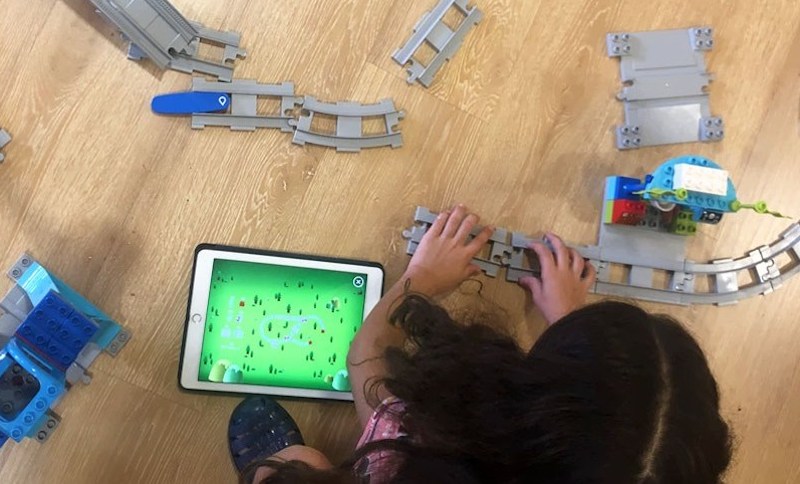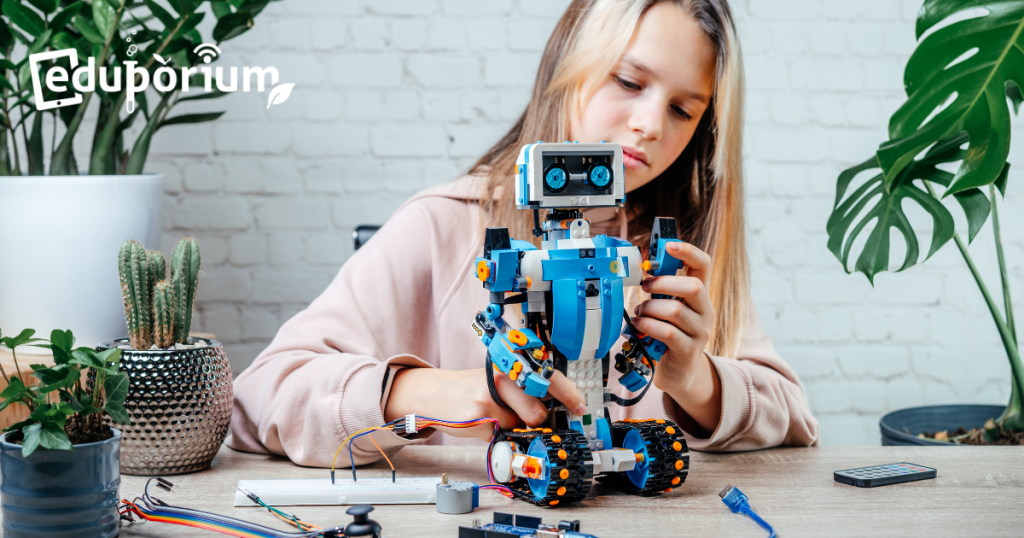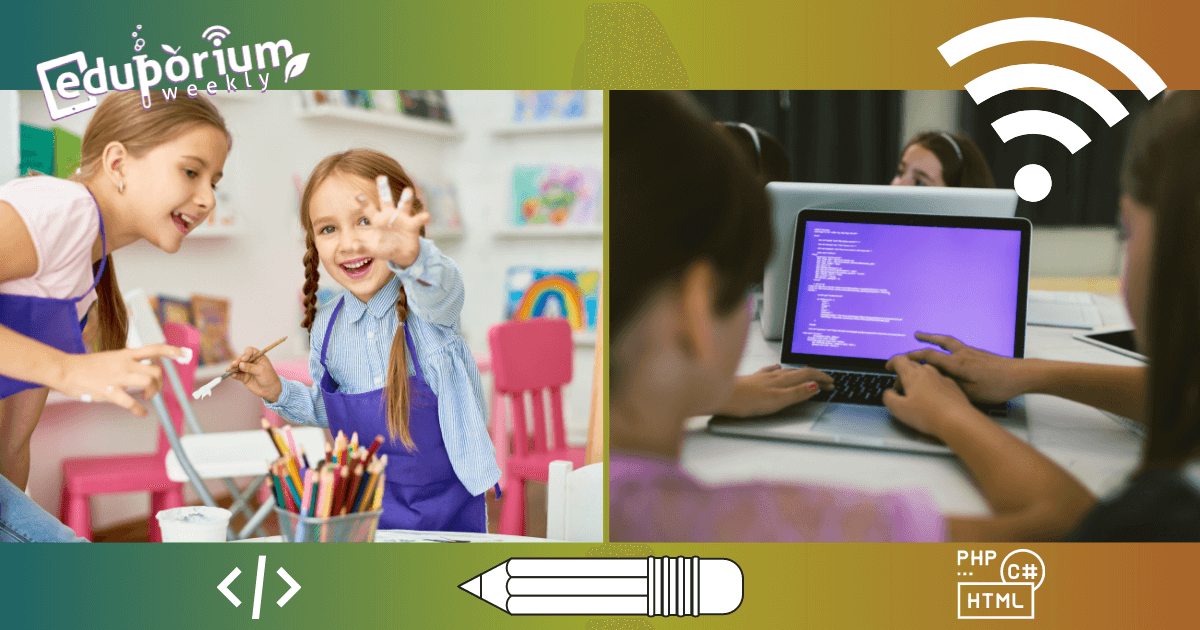Every week, we sift through many musings of EdTech experts and help teachers discover and consume the most relevant content. We share these findings on our Twitter page and, sometimes, our Facebook account as well. If you follow on Twitter (solve that if not), you may see that we tweet (a lot). Rest assured, however, it's not mindless nonsense to fill our feed with a certain amount of posts each week. We utilize the platform to truly help educators better their approaches to educating as well as regularly establish new connections. In any case, the following sections will give you a glimpse into the five most popular topics based on digital impressions to appear on our Twitter feed in the last week as we analyze STEM education.
STEAM for Young Learners
With such a broad title, this could offer many possibilities and help many educators learn new things about integrating STEAM. It appeared in the Huffington Post back in 2017, but its essence still resonated with our followers in late 2018. The post begins with a quote from Albert Einstein, which reads “The important thing is to never stop questioning.” This really resonates with us, and also with this commitment to help teachers provide educational experiences that evoke curiosity while actively engaging students—whether they’re all using technology or not. Through STEAM education, students generally feel empowered to do much more and the restraints on their creativity largely evaporate. Especially for younger students, this helps get them more comfortable with exploration, productive failure, and solving problems in new ways.
The article begins with a flashback to the teaching career of the author. She'd begun teaching in the 1970s and was always taught to incorporate elements of different subjects into teaching in order to help students make connections among all of the different ideas they were learning. If kids were learning about buildings, for example, they'd construct theirs using blocks, measure their heights, and analyze like architects. At the same time, language and literacy development revolved around vocabulary they would use as part of their current project, like names of tools and shapes of structures. She said they'd also talk about other factors associated with constructing a new building—the jobs that would be created, the amount of money it can cost, and how this building fit into the modern world. This is a fine way of creating real-world connections through early learning, but it's no longer as commonplace.
She goes on to say that she's disappointed that modern instruction is moving further from these hands-on approaches. If educators move away from it, however, she is happy this usually means they're focusing on fostering STEAM skills. This is similar to her own and approach she thinks that interconnecting the content, incorporating thinking, and leaving room for play is equally beneficial for today’s students. She also defines STEAM as science and technology interpreted through the actual designing of something with engineering and the arts—one incredibly insightful way to look at things. According to her, science is a way of thinking, technology is a way of doing, engineering is a way of building, art is a way of creating, and math offers us some way of measuring. It helps articulate STEAM for young students and it’s great to put in practice.

Afterschool Coding Programs Position Kids to Be Future Leaders
For this post, we were happy that it was so well-received because its title alone conveys a couple of the most important elements within 21st century education in our opinion. Coding is one of—if not the most important—skills students will need to be successful in the future. They are also going to need soft skills, however, and leadership's certainly one of them. Tying in with that whole active learning and 21st century education combination, afterschool coding clubs help kids practice working through problems and also working with others to solve each of those. Those with stronger computer science skills have value in job markets with CS professionals among the most in-demand positions currently. This made it necessary for students to develop computer science skills as early as possible. Since computer science doesn't always fit into the curriculum, however, teachers are turning to afterschool clubs to create these experiences.
The posting appeared on the EdTech for Beginners site and its author seemingly agrees with much of what we believe. Many teachers collectively believe that coding is a fundamental skill today, but some still prefer the old-fashioned way. As the author reiterates, many of the computer science skills students will need still aren't a part of today’s curricula. That is why parents and teachers who cannot deny their importance have created afterschool clubs for students to practice programming. Whether they are practicing programming techniques using online platforms or physically coding with tools like robots, these clubs and experiences could spur future successes. And, kids could learn new skills through research-based inquiry and play.
Continuing further, the author states that a self-paced approach is best when learning to code. Since there are many different options, it is best for teachers and students to discover what works best for them. Many of the different robotics tools have a curriculum associated with them and allow children to learn different programming languages. For example, they can learn JavaScript techniques using the BOLT or learn about Python by coding with an Edison. Plus, depending on the size of your afterschool clubs, teachers could be there for one-on-one support for kids who may be struggling to grasp what they need to know. Whether it’s every day or maybe just once or twice monthly, these coding clubs should supplement in-class academics. And, teachers can continue to turn to them if they can't fit coding into the school day.
A Closer Look at How Art Fits into STEM
At Eduporium, littleBits is one of our most valued and most successful partners. They’re also great across social media. This next article is from their blog as they looked at the importance of art when talking about STEAM education. For at least the last few years, the littleBits team has made it their mission to make sure teachers remember the ‘A’ in STEAM, to get girls involved in engineering, and to inspire children to pursue inventing. They began by stating that STEM curricula are increasingly important, especially for middle and high school, due to the economy. They even said that STEM will be indispensable for solving many of our world’s current problems. Because the same economy also demands creativity, critical thinking, and very clear communication, many teachers keep pushing to bring the arts into more of a focus for 21st century education. And, that's how STEAM learning comes into play.
These days, STEAM gets greater support, including from some prominent organizations, like the National Science Foundation and Dept. of Education. Educators realize that some of the world’s highly successful artists are also some of its best critical thinkers and are using this premise to ignite student creativity with art as a catalyst. With that said, there are plenty of ways in which instructors can incorporate art into their STEM teaching. One way to begin is to identify the aspects of art that best align with the STEM concepts you're teaching. It also says that it’s hard to imagine any field scaling in this economy without technology (including art). Today’s artists include graphic designers, cartoonists, and animators, all using technology for creating their masterpieces. With STEAM in your curriculum, students can grow into self-starters and dynamic thinkers, perfect for what the future will demand.
STEAM learning is best with exploration, and educational technology tools, especially littleBits, are great when illustrating key 21st century concepts. The best STEAM learning happens when teachers keep their input to a minimum and allow students to drive their learning. Through STEAM experiences, students can try some problem-solving methods while focusing on real-world discovery in a collaborative environment. This also helps them connect the most important concepts across various disciplines and affect learning outcomes in a positive way. To find the entire article, visit the littleBits blog and to explore littleBits along with other brands, visit our store.

Boosting Confidence to Get More Girls into STEM
It's a common belief that one main reason girls pull away from STEM is because they're not interested in it. A more accurate way to look at it, however, is that there are also girls who are interested in STEAM, but shy away from this since they'd lack a certain confidence and the sense of inclusion they find is necessary. In our fourth-best performing post last week, we shared an article from Computing covering this very topic. At this progressive, 21st century education company, we think that all kids should experience STEAM learning early in their lives. Of course, this includes girls. So, it’s no surprise this article resonated with our audience as this author shared she is passionate about girls in STEM. She begins with revealing that just 15 percent of the UK STEM workforce (the origin of the post) is women. Increasing that number is a good start.
What’s more alarming is the data on how just 11 percent of women between 18-24 years old felt ready for the STEM demands of the modern economy. We are guessing this number is not too far off from what it is like in America, either. The results also suggested these girls have the ability to pursue STEAM, insinuating that they'd shied away because of confidence. In order to boost STEM confidence in girls, they must be able to experience STEM learning in a comfortable environment. This is part of the reason why Girls Who Code and Black Girls Code sprouted up and became so popular. Each offer girls a chance to try STEAM with other girls—eliminating some societal pressures that occur in comparable situations. They'll need a similar experiences within STEM subjects, however, to start building that much-needed confidence.
The article also provides some legitimate examples for how to increase girls’ interest in STEM starting at a younger age. One of those ideas is to surround them with strong role models, which can definitely make a difference in their potential future careers. They should also provide support the whole time these girls are in school whether they need help to accomplish something or they're starting to second guess if STEM is for them. It all leads back to closing the confidence gap in girls when it comes to STEAM—something the author believes (and we agree) must be narrowed. If there's a link between girls' confidence in their STEM abilities and female participation in STEAM, it's imperative to inspire them at every intersection. Hands-on experiences and balanced guidance can be key for helping girls gain confidence to take part in STEM and solidify the next generation of female leaders.
The Effectiveness of Afterschool STEM
If you ask us, there’s nothing wrong with kids getting their exposure to STEM opportunities before, during, or after school. We know that the reality is that many students are unable to experience coding challenges during the school day because their schools do not have the resources or the time to work coding into the curriculum. They still need to develop coding skills in order to be put in the best possible position for the future, however. That is why informal, afterschool activities can be so beneficial for students. Presumably, they’re not going to be spending a ton of time at these meetings—just enough, in fact, to begin building the skills they need. In the fifth and final popular post from last week, we’re going to take a look at how afterschool coding clubs can help kids develop key STEM skills in a slightly less rigorous environment.
The article appeared on EdTech 4 Beginners and offers a look at how coding practice can position kids for success. One of the key points is that the atmosphere within afterschool coding clubs is different because there is less pressure on kids when they’re not in an academic setting. They can feel free to try new things, make mistakes, and collaborate with friends on new kinds of projects. Even if educators prefer focusing on STEM areas beyond coding, they could utilize afterschool time to teach 21st century skills. It's also a great time for kids to experience added collaboration, critical thinking, and hands-on problem solving. Heck, kids don’t even need any technology. Students can solve problems with real-world implications by mapping out certain scenarios or creating designs with simple materials.
All in all, whether children gain coding experience during the school day or afterwards, it’s just important to gain it. Evidence points to coding as an incredibly important skill for the future, obviously making learning it just as important. A couple of decades back, we never thought almost everyone’s job could revolve around using a computer. Now, it’s weird to think that some jobs don’t require one. There is a pretty strong chance that, in the coming decades (or sooner), the same will be true about coding. That is why we don’t care how or when students try coding—just as long as they do. If you’re looking to bring coding into your classroom, try checking out the Robotics and Coding section of our store for all kinds of computer science tools. And, check out our social media channels to catch all of the latest content that we share!
For the latest EdTech, STEM, and 21st century education news, follow us on Twitter and Instagram. Like us on Facebook, too, or sign up for our newsletter for announcements on the best EdTech deals around! Have an idea for an Eduporium Weekly theme? Send a message on any of our social media accounts!



